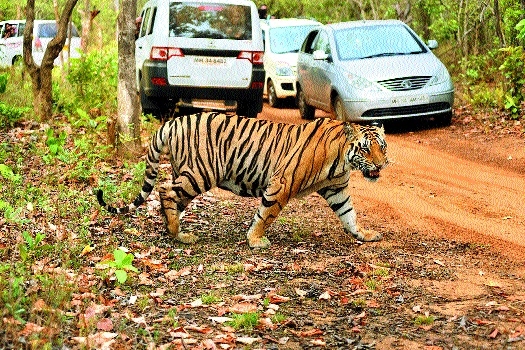Though the Tiger Day reports in media were dominated mostly by the figures of tiger mortality especially in Madhya Pradesh, not many looked into the tiger population estimation results. The results of the latest estimation are yet to be declared officially but there is likely to be a rise in tiger population in Maharashtra. It is learned that tiger population in Maharashtra has risen to around 400 since the last estimation results were declared four years ago. Though it is a good news for tiger conservation, there is a bit of a worry for Vidarbha. For, as much as 97 per cent of the State’s estimated tiger population is learned to have been reported in this region alone. Given the past trend, this is likely to add to the worries of Forest Department which will have to face more intense challenge of managing man-tiger conflict. National Tiger Conservation Authority (NTCA) and Wildlife Institute of India (WII) undertook an exercise to scientifically prepare the report on tiger population estimation.
The previous reports using transact line method were prepared every four years since 2006. As per the available data, Maharashtra had recorded tiger population of 103 in 2006. It was followed by 168 in 2010, 190 in 2014, and 312 in 2018. Continuing with the trend, it is learned that the 2022 e stimation results peg tiger population in Maharashtra to be around 400. Some have pegged it at 396. According to sources, as much as 97 per cent of the estimated tiger population of Maharashtra is likely to be concentrated in Vidarbha region alone. Within Vidarbha also, Chandrapur district alone may be host to over 230-plus tigers, that is, around 59 per cent of State’s estimated tiger population. Another source said that, the latest report (2022) estimates tiger population on the basis of previous year’s estimation as the latest exercise could not be completed within the set deadline due to tiger attack on a forest labourer woman in Tadoba-Andhari Tiger Reserve.
As per the report prepared in 2021, Vidarbha region had tiger population in the range of 376-433. When ‘The Hitavada’ contacted Sunil Limaye, Principal Chief Conservator of Forest (Wildlife), he said that the WII was yet to finalise its report but the tiger population in Maharashtra had registered an increase to around 400. “We are happy about it. At the same time, we realise that it calls for making people more aware about tiger movement, so as to manage human-tiger conflict more effectively,” he said. Increase in tiger population and rise in human-animal conflict has emerged as a big challenge in the past few years, especially in Vidarbha region. Tiger population concentrated in a geographical area, territorial fights, tigers moving out in search of new territory for themselves, humans moving inside forest for their livelihoods and taking cattle for grazing, human settlements and farmlands closer to forests etc have been flagged as matters of concern by the experts. With the latest rise in tiger population in Vidarbha, human-animal conflict is likely to intensify in days to come. According to experts, despite tiger mortality also continuing, the survival rate of the big cat especially in Vidarbha has been higher than that in other parts of the State.
Chandrapur district of Vidarbha has emerged as one of the hotspots in the country in human-animal conflict. As a possible solution, four tigresses are proposed to be shifted from hotspot areas to landscapes where there is little population of tiger. After monsoon, that may happen. The tigresses are likely to be shifted to Navegaon-Nagzira, Gadchiroli, and Sahyadri tiger reserve. According to officials, there has been a demand for tigers from states like Bihar, as well as from other countries. If the initial experiment of shifting of four tigresses is successful in terms of their breeding in new place, more tigers may be shifted as part of the larger human-animal conflict management plan.











More Stories
6 महीने में मर जाओगे… 230 किलो के अदनान सामी को जब डॉक्टर ने दी थी चेतावनी
Meghalaya murder: Last voice message to family from Indore tourist’s wife adds to chilling puzzle
Virat Kohli Breaks Silence On 11 Deaths Due To Stampede At RCB’s IPL 2025 Title Celebration